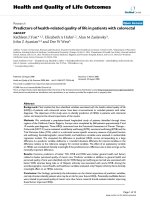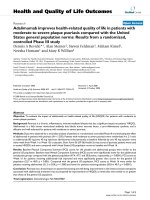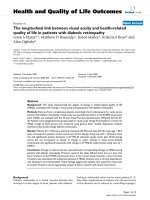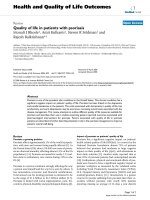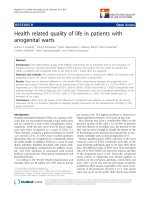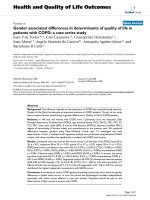Study of bacteriological profile and antibiogram of bile in patients with and without gall-stones
Bạn đang xem bản rút gọn của tài liệu. Xem và tải ngay bản đầy đủ của tài liệu tại đây (415.38 KB, 11 trang )
Int.J.Curr.Microbiol.App.Sci (2019) 8(4): 2726-2736
International Journal of Current Microbiology and Applied Sciences
ISSN: 2319-7706 Volume 8 Number 04 (2019)
Journal homepage:
Original Research Article
/>
Study of Bacteriological Profile and Antibiogram of Bile in Patients with
and Without Gall-Stones
R. Ambica*, Bhavesh Rathod C. Bhavana
Department of Microbiology, Bangalore Medical College and Research Institute,
Karnataka, India
*Corresponding author:
ABSTRACT
Keywords
Bacteriological
profile,
Bile,
Gall-stones
Article Info
Accepted:
20 March 2019
Available Online:
10 April 2019
This is a prospective study done in 2 tertiary care hospitals and a super-specialty hospital
attached to a medical college. 50 patients undergoing cholecystectomy were included in
the study. Patients with even a single macroscopic gall-stone anywhere in the biliary tract
were included in Category-A and the rest in Category-B. The aim of the project was to find
out the difference, if any, in the bacteriological profile and antibiogram of bile in patients
in these two categories which cover most of the causes of cholecystitis, and help in better
management of these patients especially in places where facilities to drain and culture bile
are not available. The bile collected was immediately taken to microbiology department
and inoculated into Selenite-F broth and BHI broth and incubated at 37ºC. Cultures were
performed on sheep blood agar and MacConkey agar. Bacterial identification was done
based on standard biochemical reactions and antibiogram performed as per CLSI
guidelines 2014. 68% of Category-A patients had positive culture in contrast to 80% in
Category-B. Category-A was dominated by females in their 5th and 6th decade while
Category-B had males in their 6th and 7th decade. Klebsiella and E.coli were equally
frequent in Category-A patients while the Category-B was dominated by E.coli.
Enterococcus was third most common (13.5% of all positive cases). Pseudomonas, Gram
negative non fermenters (GNNF) covered the rest. Cholangiocarcinoma was more prone to
bacterial invasion than peri-ampullary carcinoma. Only around 8.1% of the cases are
associated with poly-microbial infection. There seemed to be some association between
biliary stricture and GNNF. Antibiogram was almost similar in the two categories with
overall in vitro sensitivity being maximum with Amikacin (81%), followed by
Piperacillin-tazobactum (77%), and Gentamicin (64%). Cefepime (13%), Ampicillin
(22%), Amoxicillin-Clavulanate (23%), Cefotaxime (27%), Ciprofloxacin (29%) showed
poor sensitivity.
Introduction
Once considered the disease of West and
affluent, today gall-stones and other gallbladder diseases are establishing themselves
in developing countries also1. Infection of
gall-bladder and its complications is an
important cause of morbidity and mortality in
these patients2. The pathogenesis of bile
infection is incompletely understood, with the
prevailing theories not fully explaining all the
observations3.
2726
Int.J.Curr.Microbiol.App.Sci (2019) 8(4): 2726-2736
Acute cholangitis refers to inflammation of
the biliary ductal system from bacterial or
non-bacterial infection, usually in the setting
of biliary obstruction4. The main factors in the
pathogenesis of the acute cholangitis are
biliary tract obstruction, elevated intraluminal pressure and infection of bile5. The
bile is normally sterile but in the presence of
obstruction, the chances of cholangitis
increases2.
The micro-organisms are proposed to enter
the biliary tree from duodenum, through
portal vein, etc., though with varying levels of
certainity2. There are some studies on
microbiological profile of bile in gall bladder
diseases which have shown that the risk for
infection development varies with the primary
condition6,7,8. Thus, different gall bladder
diseases differ in probability of developing
infection and also the micro-organisms
involved in it, depending on the route of entry
of micro-organisms. There are only a few, if
any, microbiological studies on various gall
bladder diseases individually, excepting gall
stones. Thus there is a need of data for
infections secondary to other causes, which
might help the doctor use a more appropriate
antibiotic specific to patient’s condition. But
since infection is usually due to gall-stones –
60-80% of the times[3,9], and that the other
causes like obstructing primary tumours, gallbladder carcinoma, benign strictures, primary
stenosing
cholangitis,
parasites
and
2
hemobilia , altogether constitute only 20-30%
of the cases, microbiological study of
individual problems is difficult, and less
accurate.
This analysis inspired us to attempt on finding
the common bacterial flora in patients with
other gall-bladder conditions. We grouped the
patients into two, one with gall-stones and
one without gall-stones but with some other
underlying gall-bladder conditions, which
would include all other risk factors for
infection mentioned above. We found the
common microbial flora in the two groups
and the antibiotic susceptibility patterns, and
thus helping in judicious use of antibiotics.
Materials and Methods
This prospective study on bile was carried out
in two tertiary care hospitals and a superspecialty hospital attached to Bangalore
Medical College and Research Institute, over
a period of two months in 2017. Total of 50
patients diagnosed with cholecystitis and
undergoing cholecystectomy were included in
this study which comprised of 25 patients
having gall-stones, labeled as Category-A and
25 patients having no gall-stones but other
pathology which was responsible for their
cholecystitis, labeled as Category-B.
5ml of bile sample was collected in a sterile
container with permission of the operating
surgeon using standard precautions, and was
appropriately labelled to include the patient’s
name and the presence or absence of gallstones, to avoid mixing of the data. It was
immediately taken to the Microbiology
department and 1ml of the bile was inoculated
into BHI broth and another 1ml of bile was
inoculated into Selenite F broth. Then, direct
streaking of bile on 5% sheep blood agar and
MacConkey agar medium was done and
maintained at 37oC overnight.
After 6 hrs of incubation in Selenite F broth,
sub-culture on blood agar was done. And after
overnight incubation in BHI broth,
subcultures were done in both MacConkey
and Blood agar culture media.
The isolates were identified by standard
biochemical reactions10 and were subjected to
antibiotic susceptibility testing as per CLSI
guidelines 201411by modified Kirby-Bauer
disk diffusion technique on Muller Hinton
agar.
2727
Int.J.Curr.Microbiol.App.Sci (2019) 8(4): 2726-2736
Results and Discussion
Category-A
Out of 25 patients belonging to this group, 19
(76%) were females and 6(24%) were males
(Table 1). The average age was 51 years
(females - 47 years; males - 58 years). 68% of
the cases were positive for bacterial growth.
E. coli and Klebsiella were the most
frequently isolated bacteria accounting for
41.17% and 35.29% of the positive cases
respectively. Together they were responsible
for 52% of all the cases or 76.47% of the
culture positive cases. Pseudomonas, other
Gram negative non fermenters and
Enterococcus covered the rest of the positive
cases. Poly-microbial growth was less
frequent (4%). Resistance was common
among bacteria for Ampicillin (14%),
Amoxicillin-Clavulanate (9%), and Cefepime
(14%). Bacteria were sensitive to Amikacin
(81%), Piperacillin-Tazobactum (78%) and
Gentamicin (69%). Co-trimoxazole (45%)
and Ertapenem (50%) also showed relatively
favorable sensitivity pattern.
Two cultures yielded Pseudomonas which
were multi-drug resistant. One was resistant
to Gentamicin, Ciprofloxacin, Amikacin,
Imipenem,
Cefepime,
Aztreonam,
Ceftazidime, Ticarcillin and Piperacillin, and
sensitive only to Polymyxin-B. The other case
where pseudomonas was isolated was
resistant to Cefotaxime, AmoxicillinClavulanate,
Piperacillin-Tazobactum,
Cefepime, Aztreonam, Ceftazidime, and
Piperacillin, but was sensitive to Imipenem.
Category-B
Out of 25 patients belonging to this group, 8
(32%) were females and 17 (68%) were males
(Table 1). The average age was 57 years
(females - 49 years; males - 60 years). This
category is composed of peri-ampullary
carcinoma, Cholangiocarcinoma, biliary
stricture, carcinoma of gall-bladder, mass in
the head of pancreas. The age-wise
distribution of these cases is depicted in
Figure 2. 80% of the cases were positive for
bacterial growth. Case-wise distribution of
micro organisms and antibiotic sensitivity is
given in Table 2. E. coli was very much more
frequent than Klebsiella in the ratio of 3.25:1
and were together responsible for 85% of the
positive cases. Gram negative non fermenters
and Enterococcus covered the rest of the
positive cases. Poly-microbial growth was not
infrequent (8%).Resistance was common
among organisms for Ampicillin (27%),
Cefotaxime (11%), Amoxicillin-Clavulanate
(31%) and Cefepime (13%). The organisms
were sensitive to Amikacin (80%),
Piperacillin-Tazobactum
(76%),
and
Gentamicin (60%).
The comparison of bacterial isolation pattern
and antibiotic susceptibility pattern in
Category A and B is depicted in Table 3 and
Figure 1 respectively.
Total of 50 patients were included in this
study which comprised of 25 patients having
a gall-stones and 25 patients having no gallstone but having other pathology which was
responsible for their cholecystitis. Those with
gall-stones were labelled category-A patients
and the others as category-B patients. The
median age of patients was 54 years.
Male:Female ratio was 0.85:1.
Patients belonging to category A had a
median age of 51 years with female to male
ratio being 3.16:1. Thus, gall-stone disease is
predominantly a disease of females in 5th and
6th decade of their lives. The culture positivity
was seen in 68% of the cases, slightly higher
from other studies probably because ours is a
tertiary care hospital and also because we
were able to inoculate and streak the sample
within an hour. Manan et al.,3 (2014) had an
2728
Int.J.Curr.Microbiol.App.Sci (2019) 8(4): 2726-2736
isolation rate of 58.73% while Capoor et
al.,6(2008) had an isolation rate of 32%. Only
one case showed a polymicrobial growth. E.
coli and Klebsiella dominated the scene in
this category with each of them almost
equally frequent covering 76.47% of all the
positive cultures. This finding is in
consistency with findings of Capoor et
al.,6(2008) and Manan et al.,3(2014). Two
cases gave growth of Pseudomonas which
was resistant to almost all the drugs with only
a drug or two being spared. The organism
showed significant resistance to ampicillin
with only 14% of the cultures being sensitive
to it. This was also noted in the studies of
others. Amoxicillin-Clavulanate also showed
very low efficacy, with only 9% of the
cultures being sensitive to it. The sensitivity
rates with Cefepime and Ciprofloxacin were
also very low, with only 14% and 22% of the
cases
yielding
sensitive
organism
respectively.
Amikacin
(81%)
and
Piperacillin-Tazobactum (78%) were the most
effective antibiotics for this category of
patients. Gentamicin (69%) also showed
favorable sensitivity patterns. This is in
contrast to the findings of Manan et al.,3
(2014) and Shenoy et al.,7(2014) who found
that most bacteria were sensitive to
cephalosporins, indicating the regional
variation of resistance pattern. Even Capoor et
al.,6 (2008) found Piperacillin-Tazobactum
very sensitive. According to Wu et al.,12, the
stone may be acting as a source of infection
with the bacteria trapped in the centre. In such
cases, it becomes imperative to remove the
stones prior to antibiotic therapy.
carcinoma of gall-bladder, mass in the head of
pancreas, etc. All these cases are associated
with some form of biliary obstruction and
biliary stasis probably indicating biliary stasis
as the main cause for bacterial invasion.
Based on their study findings, Yusoff et al.,2
(2003)also concluded that biliary stasis was
responsible for infection. The culture
positivity was noted in 80% of the cases with
2 cases showing multi-bacillary growth
representing 8% of the total number of cases
or 10% of the positive cases. This is again
expectable based on the consideration that
these pathologies were responsible for a long
period of obstruction of biliary tract. E. coli
alone dominated the scene with E. coli to
Klebsiella isolation frequency being 3.25:1
with E. coli alone contributing to 65% of the
positive cases. Klebsiella accounts for 20% of
the positive cases. Enterococcus was
responsible for 15% of the positive cases.
Also, two cases yielded Gram negative nonfermenters.
Patients belonging to Category-B had a
median age of 57 years with female to male
ratio being 0.47:1. Thus aculculous
cholecystitis requiring surgical intervention is
usually a disease of males in the 6th and 7th
decade of their lives. This category is
composed of peri-ampullary carcinoma,
Cholangiocarcinoma,
biliary
stricture,
On the other hand, cholangiocarcinoma which
represented 24% of cases in this category,
there was 100% bacterial isolation rate with
33.3% cases showing multi-bacillary growth.
So, it is relatively more prone to develop
bacterial infection. This probably is because
of the early obstruction of the biliary tract as
compared to peri-ampullary carcinoma and
The commonest pathology in this group was
Peri-ampullary carcinoma accounting for 10
cases or 40% of the cases in this group. It
showed male preponderance (M:F=7:3).70%
of the cases yielded positive culture but not a
single case was associated with multibacillary growth. E. coli dominated the scene
with E. coli representing 86% of the positive
cases. Klebsiella represented 14% of the
positive cultures. So, compared to the 80%
isolation rate as a whole in this category, it
was less frequently associated with bacterial
isolation.
2729
Int.J.Curr.Microbiol.App.Sci (2019) 8(4): 2726-2736
hence again indicating that obstruction is the
main cause for bacterial invasion. 100% of
the cases showed presence of E. coli. One
case additionally had Klebsiella, and the other
had Enterococcus. Male to female ratio was
5:1.
Gall-bladder carcinoma accounted for 3 cases
in this category. All the three were females in
their 6th decade. This was associated with
culture positivity in all the 3 cases. Two cases
yielded Klebsiella and one case yielded E.
coli. Biliary stricture as mentioned had Gram
negative non fermenter in both the cases.
One case of metastatic pancreatic head mass
yielded Enterococcus. Another case of nonneoplastic head mass yielded E. coli. One
case of carcinoma of head of pancreas yielded
no growth.
We had also got a case of Caroli’s disease
which was diagnosed on surgical table which
yielded no growth.
If it is obstruction that is responsible for
bacteria to invade biliary tree, then there
should have been similar isolation pattern
with and without gall-stones.
This cannot be used to explain why E. coli is
thrice as common as Klebsiella in patients
without gall-stones.
If we think that prolonged obstruction causes
E. coli to take over Klebsiella then similar
finding would have been seen in Category-A
patients. Those who had prolonged
obstruction or long history of symptoms
would show selectively E. coli. But we didn’t
find any such selection. It is possible that
malignancy induced immune-depression may
be responsible for selective E. coli
dominance.
Resistance was common among bacteria for
Ampicillin (27%), Cefotaxime (11%),
Amoxicillin-Clavulanate (31%) and Cefepime
(13%). Bacteria were sensitive to Amikacin
(80%), Piperacillin-Tazobactum (76%), and
Gentamicin (60%).
There was not much difference in the
antibiotic sensitivity pattern of the isolated
bacteria from the two cases as a whole as is
evident from Figure 1. Morever, there was no
significant difference in antibiotic sensitivity
pattern of the E. coli (Fig. 2) and Klebsiella
(Fig. 3) separately from the two categories.
The antibiotic sensitivity patterns of the
bacteria isolated from cholangiocarcinoma
and peri-ampullary carcinomais shown in
Figure 4.
Putting it all together, 74% of the cases were
associated with positive culture. Shenoy et
al.,7 (2014) had an isolation rate of 54% while
Claesson B et al.,8(1984) had an isolation rate
of 72%.54% of the positive cases gave E. coli.
27% of the cases were positive for Klebsiella.
So, E. coli was overall twice as frequent as
Klebsiella.
Other
bacteria
included
Enterococcus (13.5%), Gram negative nonfermenter (8.1%), Pseudomonas (5.4%).
Polymicrobial growth was seen in 8.1% of the
cases.
This in contrast with very high polymicrobial
infection rate of 69.5% in study of Sahu et
al.,9and31.5% in study of Shenoy et
al.,7(2014).
Overall, Amikacin (81%), PiperacillinTazobactum (77%), and Gentamicin(64%)
showed favourable sensitivity. Cefepime
(13%), Ampicillin (22%), AmoxicillinClavulanate (23%), Cefotaxime (27%),
Ciprofloxacin (29%) showed poor sensitivity
(Fig. 5 and 6). This was in consistency with
M K Sahuet al.,9 who also found significant
resistance of bacteria to third generation
Cephalosporins
and
Ciprofloxacin.
2730
Int.J.Curr.Microbiol.App.Sci (2019) 8(4): 2726-2736
Table.1 Age-wise distribution of the cases in Category A and B
Age range of the patients
Category-A
Male
Female
0
5
0
3
2
3
1
2
3
3
0
1
0
2
6
19
20-30 years
31-40 years
41-50 years
51-60 years
61-70 years
71-80 years
>80 years
Total
Category-B
Male
Female
0
1
1
1
1
2
3
3
7
1
4
0
1
0
17
8
Table.2 Case-wise distribution of bacterial growth among Category – B
Pathology
Number
of cases
Median
age
Percentage Bacterial profile
culture
positivity
0
-
Carcinoma of head of
pancreas
Carcinoma of gall-bladder
1
52
3
55
100%
Klebsiella- 66.6%
E. coli- 33.3%
Cholangiocarcinoma
6
64
100%
Multibacillary in 33.3%
E. coli- 100%
Klebsiella- 16.6%
Enterococcus- 16.6%
Peri-ampullary carcinoma
10
66
70%
E. coli- 86%
Klebsiella- 14%
Billiary stricture
2
63
100%
GNNF- 100%
Metastatic pancreatic head
mass
Non-neoplastic
pancreatic
head mass
1
45
100%
Enterococcus- 100%
1
31
100%
E. coli- 100%
Caroli’s disease
1
24
0%
2731
-
Sensitive
antibiotics
Amikacin
PiperacillinTazobactum
Ertapenem
Amikacin
PiperacillinTazobactum
Cefotaxime
Gentamicin
Amikacin
PiperacillinTazobactum
Ertapenem
Gentamicin
Piperacillintazobactum
Ampicillin
Ciprofloxacin
Ampicillin
Gentamicin
Sensitive to almost
all drugs.
-
Int.J.Curr.Microbiol.App.Sci (2019) 8(4): 2726-2736
Table.3 Comparison of Bacterial isolation pattern in the two categories
Bacteria
E. coli
Klebsiella
Pseudomonas
GNNF
Enterococcus
Polymicrobial growth
Overall positive culture
No growth
Patients with gallstones(n=25)
7 (28%)
6 (24%)
2 (8%)
1 (4%)
2 (8%)
1 (4%)
17 (68%)
8 (32%)
Patients without
gall-stones
(n=25)
13 (52%)
4 (16%)
0 (0%)
2 (8%)
3 (12%)
2 (8%)
20 (80%)
5 (20%)
Fig.1 Gender-wise distribution of the cases in Category B
ABCDEFGH-
Carcinoma of head of pancreas.
Carcinoma of gall-bladder.
Cholangiocarcinoma
Peri-ampullary carcinoma
Biliary stricture
Metastatic pancreatic head mass
Non-neoplastic pancreatic head mass
Caroli’s disease.
2732
Int.J.Curr.Microbiol.App.Sci (2019) 8(4): 2726-2736
Fig.2 Antibiotic sensitivity pattern of the two categories
90
80
70
60
50
40
30
20
10
0
81 80
78 76
69
60
59
50
47
44
38
33
45 42
31
22
14 17
11
14 13
9
Amp
G
Cip
Ctx
Ak
Cx
Category-A
14
69
22
44
81
Category-B
17
60
33
11
80
Category-A
Amc
Pit
Etp
Cot
Cpm
38
9
78
50
45
14
47
31
76
59
42
13
Category-B
Fig.3 Comparison of antibiotic sensitivity of the E. coli in the two categories
2733
Int.J.Curr.Microbiol.App.Sci (2019) 8(4): 2726-2736
Fig.4 Comparison of antibiotic sensitivity of the Klebsiella in the two categories
Fig.5 Comparison of antibiotic sensitivity pattern among peri-ampullary carcinoma and
cholangiocarcinoma
2734
Int.J.Curr.Microbiol.App.Sci (2019) 8(4): 2726-2736
Fig.6 Overall antibiotic sensitivity pattern in gall-bladder diseases
In conclusion, 68% of the cases with gallstones have a detectable bacterium in their
bile, while 80% of the patients with
aculculous cholecystitis requiring surgical
intervention have some bacteria in their bile.
The second group basically refers to
malignancies of the hepato-biliary system and
pancreas. Gall-stone disease is predominantly
a disease of female in their 5th and 6th decade
while malignancies of the biliary tract and
pancreas are diseases of males in their 6th and
7th decade. E. coli is twice more common than
Klebsiella overall. Inturn, Klebsiella is twice
more common than Enterococcus overall.
Patients with gall-stone have almost equal
chance of E. coli and Klebsiella invasion
while in the malignancies E. coli is thrice
more commoner. Amikacin, PiperacillinTazobactum and Gentamicin are preferable
antibiotics for cholecystitis. Cefepime,
Ampicillin,
Amoxicillin-Clavulanate,
Ciprofloxacin, cefotaxime were usually
ineffective. To tell about the association of
biliary stricture with Gram negative nonfermenter would require a larger sample size.
References
1. Sachdeva S, Khan Z, Ansari MA,
Khalique N, Anees A. Lifestyle and
Gallstone Disease: Scope for Primary
Prevention. Indian J Community Med.
2011 Oct; 36(4):263-7.
2. Yusoff IF, Barkun JS, Barkun AN.
Diagnosis
and
management
of
cholecystitis
and
cholangitis.
Gastroenterol Clin North Am. 2003; 32:
1145-68.
3. Manan F, Khan MA, Khan M. Frequency
of common bacteria and their antibiotic
sensitivity in patients with symptomatic
cholelithiasis. J Postgrad Med Inst 2014;
28(2): 177-83.
4. Qureshi WA. Approach to the patient who
has suspected acute bacterial cholangitis.
2735
Int.J.Curr.Microbiol.App.Sci (2019) 8(4): 2726-2736
5.
6.
7.
8.
Gastroenterol
Clin
North
Am
2006;35:409-23.
Rosh AJ, Manko JA, Santen S (2014)
Cholangitis in emergency medicine.
Brenner//Medscape 2012.
Capoor MR, Nair D, Rajni, Khanna G,
Krishna SV, Chintamani MS, Aggarwal P.
Microflora of bile aspirates in patients
with acute cholecystitis with or without
cholelithiasis: A tropical experience. Braz
J Infect Dis 2008; 12: 222-5.
Shenoy S M, Shenoy S, Gopal S, Tantry B
V,
Baliga
S,
Jain
A.
Clinicomicrobiological
analysis
of
patients with cholangitis. Indian J Med
Microbiol 2014;32:157-60.
Claesson B, Holmlund D, Mätzsch T.
Biliary microflora in acute cholecystitis
and the clinical implications. ActaChir
Scand. 1984;150(3):229-37.
9. M K Sahu, Ashok C, A K Dutta, J A J
Prakash. Microbial profile and antibiotic
sensitivity pattern in acute bacterial
cholangitis.
Ind
J
Gastroenterol.
2011;30(5):204–208.
10. Collee JG, Fraser AG, Marmion BP,
Simmons A. 14th edition. New York:
Churchill-Livingstone;
Mackie
and
McCartney
Practical
Medical
Microbiology. 1999.
11. Clinical and Laboratory Standards
Institute. Performance Standards for
Antimicrobial Susceptibility Testing.
Twenty-Fourth Informational Supplement.
M100-S24, Vol 34, No 1: Wayne,
Pennsylvania; 2014. p.38-42.
12. Wu SD, Yu H, Sun JM. Bacteriological
and electron microscopic examination of
primary hepatic stones. Hepatobiliary
Pancreat Dis Int 2006; 5: 228-31.
How to cite this article:
Ambica, R., Bhavesh Rathod Bhavana, C. 2019. Study of Bacteriological Profile and
Antibiogram of Bile in Patients with and Without Gall-Stones. Int.J.Curr.Microbiol.App.Sci.
8(04): 2726-2736. doi: />
2736
